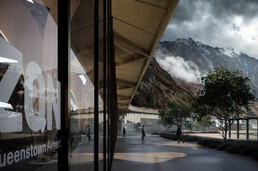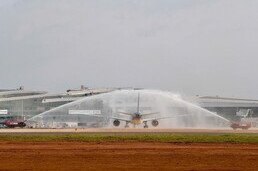
Prime Minister of India inaugurates Delhi Airport's expanded integrated Terminal 1
- 2024-03-11
Hon’ble Prime Minister Shri Narendra Modi today dedicated the expanded world-class integrated Terminal 1 of Delhi Airport to the nation. With this, he revealed the future of air travel as Delhi Airport, under the stewardship of GMR-led DIAL, prepares to operationalize the revamped Terminal 1. This integrated T1 is not merely an expansion; it's a catalyst for a paradigm shift in passenger experience.
With a capacity to serve a whopping 40 million passengers per annum (MPPA) - doubling its previous capability - Delhi Airport now stands among elite global hubs, boasting a 100 MPPA capacity. The integration of Arrival and Departure terminals is not just architectural; it's a transformative journey, resonating with India's ambition and connecting the nation to the world.
GMR Airports Infrastructure Ltd (GIL)-led DIAL undertook the expansion work in 2019 to make Delhi Airport future-ready. The expansion work was carried out as per the Master Plan 2016 as Delhi Airport witnessed a massive surge the Air Traffic Movements (ATMs) and passenger numbers, exceeding projections.
Marking the conclusion of the Phase 3A Expansion project, the expanded terminal signifies a monumental leap in Indian aviation. Spearheaded by GMR Airports Infrastructure Ltd (GIL)-led DIAL, this endeavor embodies our nation's ambition, fostering growth, innovation, and job creation.
Speaking on the occasion, Mr I Prabhakara Rao, Group Deputy Managing Director, GMR Group, said, “The Delhi Airport Phase 3A Expansion project, a monumental undertaking driven by GMR Airports Infrastructure Ltd led DIAL, is more than bricks and mortar; it's a testament to our nation's ambition and a catalyst for its continued growth. We stand together to celebrate the completion of a project and witness the dawn of a new era for Indian aviation. Terminal 1 enhances capacity and redefines the passenger experience while embracing sustainability. The expanded integrated terminal, a marvel of innovation and aesthetics, will serve 40 million passengers annually, double its previous capacity. Through this project, we have reimagined a seamless journey facilitated by facial recognition, self-service kiosks, and automated baggage systems. Spacious concourses bathed in natural light, offering a haven of comfort with prayer rooms, yoga areas, and quiet zones are its integral part. This project is about India's aspirations and positions the National Capital as a Gateway to New India, connecting us closer to the world and boosting our economic prospects. It creates jobs, fosters innovation, and paves the way for a brighter future for our nation. As we celebrate this milestone, let us remember that this is just the beginning. The journey ahead is filled with exciting possibilities. We will continue to innovate, collaborate, and push boundaries to ensure that Indian aviation soars to new heights.”
TERMINAL 1: REDEFINING PASSENGER EXPERIENCE
Delhi Airport's Terminal 1 is not simply an expansion; it embodies a fusion of elegance, innovation, and a steadfast commitment to enhancing passenger experiences. The consolidation of Arrival and Departure terminals into a cohesive structure significantly increases the overall area, soaring from 55,740 sqm to an impressive 206,950 sqm. This expansion is more than three times the previous area and augments the capacity from 17 MPPA to 40 MPPA, which is more than double the previous capacity.
Passenger facilities are at the forefront, utilizing advanced technologies such as Facial Recognition System (DIGIYATRA) at all entry gates, 20 Automated Tray Retrieval System (ATRS), Individual Carrier System (ICS), 108 Common Usage Self Service (CUSS), 100 check-in counters including 36 Self Baggage Drop (SBD) kiosks among others. The seamless journey is complemented by a myriad of offerings, including expanded baggage reclaim carousels, multiple entry gates, and enhanced Shop and Dine facilities.
ENHANCED PRM FACILITIES
To enhance the experience of Passengers with Reduced Mobility (PRM), DIAL has created special zones for PRMs on the Kerbside which include a Lounge facility, phones, Sunflower Service, etc. DIAL has also established special zones and elevated seating arrangements for PRMs inside the terminal.

PASSENGER FACILITIES
The integrated terminal boasts several passenger-friendly facilities using advanced technologies such as Facial Recognition System (DIGIYATRA) at all entry gates, 20 Automated Tray Retrieval System (ATRS), Individual Carrier System (ICS), 108 Common Usage Self Service (CUSS), 100 check-in counters including 36 Self Baggage Drop (SBD) kiosks among others.
The terminal also has 10 baggage reclaim carousels, each 70 metres long, against eight of 52 metres each, with ample space between two baggage belts, reducing the waiting time of passengers. The capacity of the Baggage handling system at T1 has doubled from 3240 baggage per hour to around 6000 per hour. The number of check-in islands has also been increased to five against four earlier. These would help in the easy flow of passengers and enhance passenger experience.
Apart from these, the integrated terminal will have 24 entry points for ease of entry for passengers. Inside the terminal, passengers can experience the Shop and Dine facility, Prayer Room, Yoga area, Quiet zone, Lounges, Group seating, Laptop charging stations, mobile charging stations, self-medication room, Baby Care rooms, smart washrooms, etc. The terminal is also well connected with Delhi Metro at Arrivals and as well as Departures.

CITY SIDE DEVELOPMENTS: MEETERS AND GREETERS REIMAGINED
The Terminal's city-side developments offer an enhanced experience for Meeters and Greeters, with contemporary meet & greet zones, plush forecourt areas, and expanded parking facilities. Realigned pickup and drop-off lanes ease vehicle traffic, significantly improving the passenger experience during arrivals and departures.
SUSTAINABILITY
Terminal 1 is not merely a symbol of progress but an embodiment of sustainability. As a Green Building, designed in adherence to USGBC LEED Platinum standards, it incorporates innovative features like daylighting concepts i.e. the use of natural light and energy-efficient systems. Beyond its eco-friendly design, Terminal 1 extends its impact to the city side, introducing contemporary meet & greet zones and expanded parking facilities.
REVAMPED APRON: NAVIGATING EFFICIENCY
The redesigned apron, featuring 82 Code C stands and a dual taxiway, ensures improved air traffic flow, faster aircraft turnaround, and enhanced safety. Technological upgrades like VDGS, FHS, GPU, and PCA contribute to efficiency and safety in aircraft handling.

DESIGN CONCEPT AND ARTWORK
Delhi Airport's Phase 3A expansion, a monumental endeavour, positioned Terminal 1 (T1) as a symbol of cutting-edge design and engineering. The challenge was to seamlessly integrate a larger, state-of-the-art terminal within the bustling airport, all the while maintaining uninterrupted operations. The project successfully tripled its area and doubled passenger capacity without inconveniencing the passengers. The terminal was sliced into two parts by erecting a 19-metre-high façade of puff panel. This façade shielded the operating part of T1 from dust, smoke, and rain during the construction work.
The art and design concept focused on blending existing structures with the new, symbolizing the evolution of flight. Linear departure gates and an arrival pier along two levels seamlessly integrated the existing and the modern. The aesthetic plan signifies a harmonious coexistence, reflecting India's commitment to innovation in aviation infrastructure. It also boasts of a display of traditional and folk art forms from the remotest parts of India, representing unity in diversity.
OTHER PROJECTS UNDER PHASE 3A
Apart from the integration of Arrivals and Departures of T1, DIAL has undertaken other projects to make Delhi Airport future-ready keeping in mind its goal to become a NET ZERO-CARBON EMISSION AIRPORT BY 2030. These include as following:
FOURTH RUNWAY
As part of the Phase 3A Expansion project, DIAL has constructed a new 4.43-kilometer-long Code F runway (11L/29R), commonly known as the fourth runway, parallel to the third runway (runway 11R/29L) on the Southern Airfield, making Delhi Airport the only Indian airport to have four operational runways. The 4th runway would not only help DIAL handle the increased air traffic movements but along with the dual elevated Eastern Cross Taxiways (ECT), also provide improved operational flexibility by reducing taxiing time and CO2 emissions.
DUAL ELEVATED EASTERN CROSS TAXIWAYS (ECT)
The first-of-its-kind dual elevated Cross Taxiways on the Eastern side of the airport connects the Northern airfield with the Southern airfield. The ECT has reduced taxiing distances for aircraft, reduced aircraft emissions, saved ATF, and enhanced operational efficiency.
It will optimize taxiing routes and aircraft operations, resulting in a reduction of approximately 55,000 tonnes of CO2 per annum. The ECT also helps in enhancing passengers’ experience. It has reduced the taxi distance for an aircraft after landing on the third runway and going to T1 to 2 KM from earlier 9 KM, thus passengers have to remain inside a plane for a shorter duration after landing or during take-off.
PRIMARY RUNWAY
DIAL has refurbished and rehabilitated the British-era runway (RWY09/27). DIAL undertook the rehabilitation work of runway 09/27 as part of Delhi Airport’s Phase 3A Expansion project.
The rehabilitated runway complies with Category-I (CAT-I) Instrument Landing System (ILS), which assists pilots during landing an aircraft in low visibility conditions. The British constructed the 2,816 metre-long and 60 metre-wide runway in the pre-Independence era and used it during World War- II. DIAL has also realigned a new 3.5 KM-long taxiway, parallel to runway 09/27. This will reduce the Runway Occupancy Time (ROT) and help in improving the traffic flow.
DIAL has also upgraded the Airfield Ground Lighting (AGL) system for runway 09/27 with duct and pit system. It has laid around 58 Km of AGL ducts and 430 AGL pits (both primary and secondary combined) to connect the runway AGL systems to ESUs and facilitate smooth operations. All the existing lights of the runway and taxiways (around 850 nos.) have been upgraded to LED systems for higher efficiency and reliability as a part of rehabilitation work.
DIAL has constructed around 7.3 Km of drain on both sides of the runway, to cater to the runoff water from the newly rehabilitated runway 09/27 and its associated taxiways.
MODIFICATIONS IN TERMINAL 3:
As part of modifications in T3, DIAL has almost doubled the International-to-International transfer area. Also, a 7th check-in island has been added in T3 with associated Baggage Handling Systems, including a Self Baggage Drop facility, and two Arrival Carousels. Also, the IT systems of the entire Baggage Handling System of T3 have been upgraded. With all these enhancements, the passenger throughput of T3 would go up from 34 MPPA to 45 MPPA.
FLYOVERS
To provide a signal-free transit experience to passengers, DIAL has opened two flyovers -- Aerocity Flyover and the Parallel Access Road flyover, to help ease the traffic movement to and from Delhi Airport.
The Aerocity Flyover, a four-lane one-way flyover constructed at Aerocity metro station junction will reduce travel time from T1 to T3 of the Delhi Airport by making a signal-free movement. The flyover commences in front of Andaz Hotel, Aerocity (West side), and ends at Central Spine Road, terminating short of the dual elevated Eastern Cross Taxiways.
The Parallel Access Road (PAR) Flyover is a dedicated corridor of two lanes on both carriageways for the Cargo Terminal (To and From) of the airport, with a flyway close to NH8. The corridor commences close to Hanuman temple and ends near Andaz Hotel, thereby segregating the heavy vehicular movement from passenger vehicles and further helping decongest the airport approach road.
FIRE STATION
To ensure quick response during an emergency, DIAL has set up a new fire station on the airside









